Jewels
273 Products
-
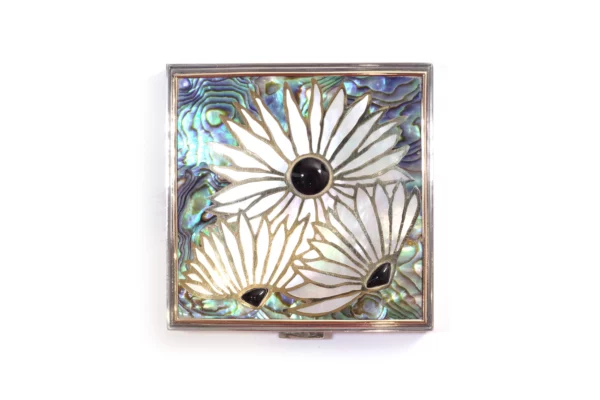
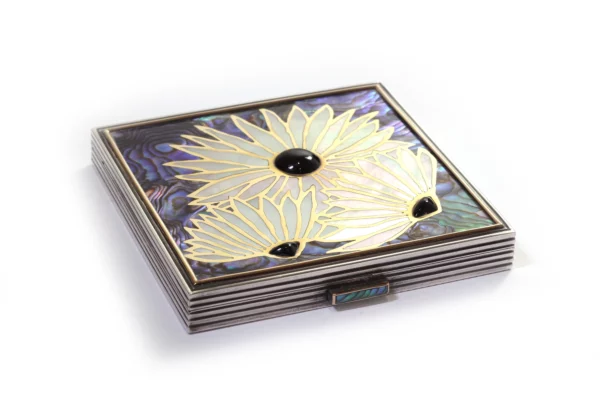 510,00€
510,00€Abalone silver powder compact with mother-of-pearl flowers in 800 thousandths silver and vermeil. This powder box is adorned with inlaid white mother-of-pearl flowers on a background of black abalone mother of pearl. The center of the flowers is embellished with black glass cabochons. The powder box opens to reveal a compartment with a faceted mirror; the interior of the box has been cleaned and still has its ostrich feather applicator. Modern-era powder box, circa 1950, France.
Hallmarks: Wild boar’s head (French state hallmark for silver) and SM silversmith’s hallmark.
Condition: Fine usage scratches
Weight: 139.84 gr
-
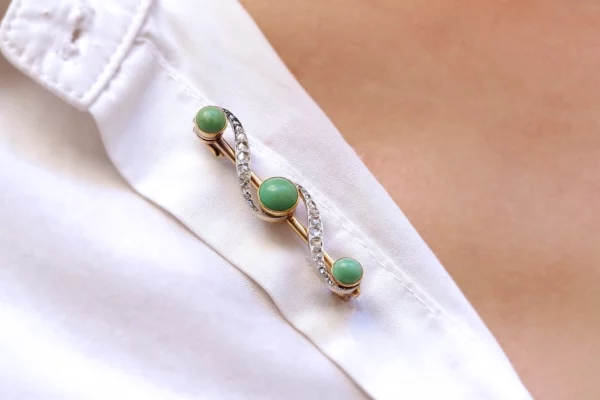
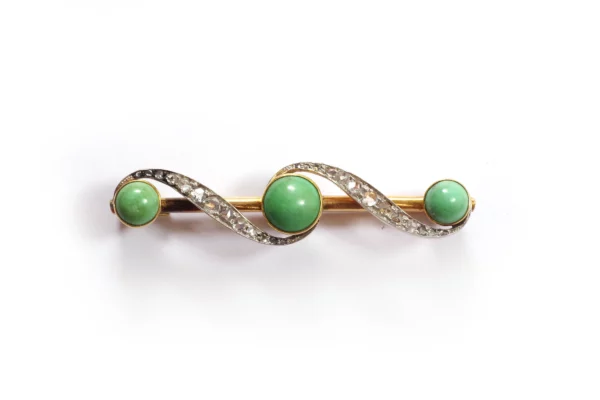 850,00€
850,00€Turquoise and diamond brooch in 18 karat (750) gold and platinum. Antique brooch set with three turquoise cabochons linked by two platinum scrolls each set with 13 rose-cut diamonds (26 in total). Art Deco brooch, circa 1925, France.
Partially inscribed eagle head hallmark (French state hallmark for 18 karat gold) and goldsmith’s hallmark.
Dimensions: 11 x 46 mm
Estimated diamond weight: 0.20 carat
Diameter of the central turquoise: 7 mm
Note: the fastening system works
Condition: scratches from useWeight : 7.38 gr
-
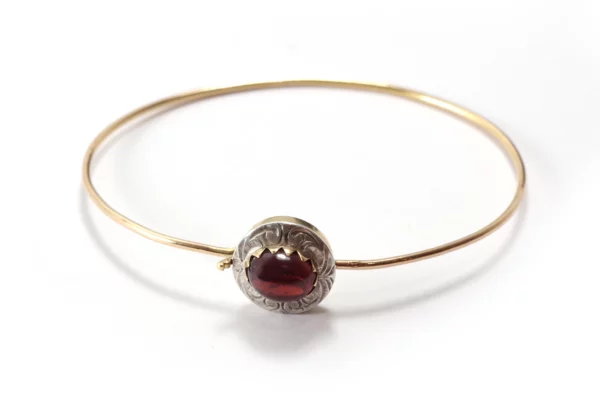
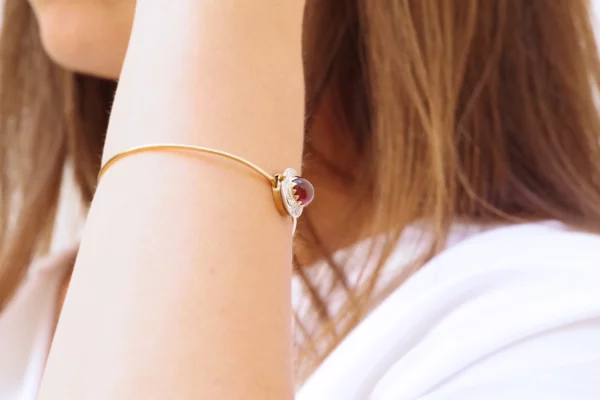 780,00€
780,00€Garnet bangle bracelet in 18-karat rose gold (750) and silver. This delicate bracelet forms a wire bangle, adorned with a circular element made of gold and silver serving as the clasp. The clasp is set with a significant cabochon garnet and features scroll motifs. The central element dates back to the 19th century and has been subsequently assembled into this fine bracelet.
Hallmarked with “charançons” (french state hallmarks for 18-karat gold) and a partially legible maker’s mark.
Inner circumference: 17 cm (approximately 6.7 inches)
Clasp dimensions: 14 x 13.8 mmCondition: Normal signs of wear, reassembly
Weight: 7.19 gr
-

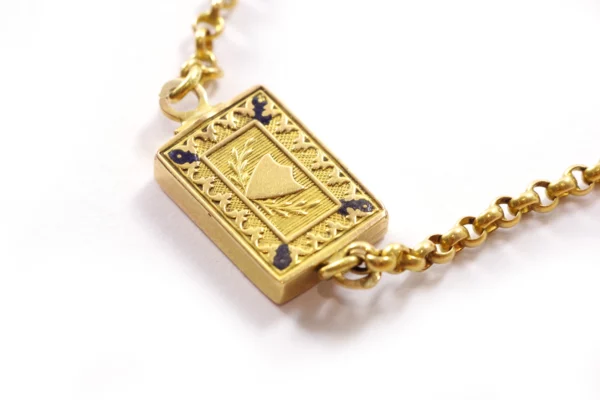 1400,00€
1400,00€French long necklace with enamel clasp and 14 karat (585) and 18 karat (750) rose gold. The 14 karat gold clasp is rectangular with two facets. The facets are decorated with enamels and motifs: one centred on a shield framed by two laurel leaves, the corners enamelled blue; the other decorated with a frieze of triangles enamelled blue, the corners enamelled white. The 18 karat gold sautoir chain is made of jaseron mesh. French regional jewellery from the mid-19th century, Normandy region.
Shell head hallmarks on the clasp, chain tested 18 karats.
Dimensions of clasp: 8 mm x 12 mm
Length of necklace: 70 cmCondition: missing enamel, scratches from use
Weight : 8.09 gr
-
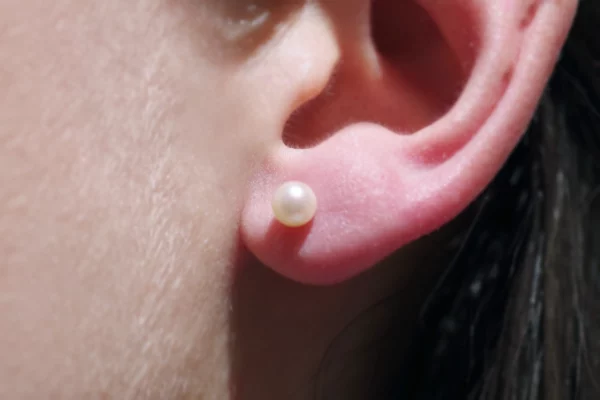
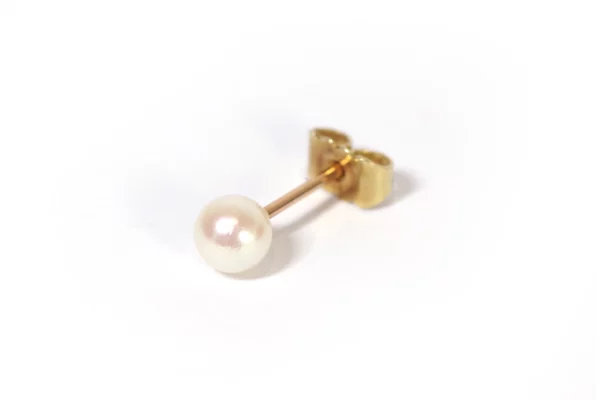 90,00€
90,00€Single pearl stud earrings. Unique ear stud adorned with a approximately 5.28 mm cultured pearl. The earring’s mount is made of 18-karat yellow gold. Single earring sold alone, circa 1980, France.
Goldsmith hallmark and eagle head hallmark
Pearl diameter: 5.29 mm
Note: butterfly push-back clasp
Condition: signs of wearWeight: 0.55 gr
-

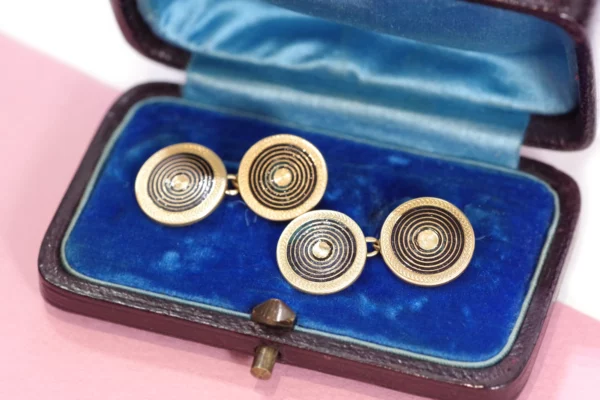 650,00€
650,00€Art Deco enameld cufflinks are made of 18 karat yellow gold and feature a circular design with black enamel concentric circles on a gold background, creating a target-like pattern. The edges of the gold circles are adorned with notched borders. These cufflinks date from the early 20th century.
Hallmark : eagle’s head
Diameter : 14 mm
Condition : slight indentation, enamel defects
Weight : 4,69 gr
-
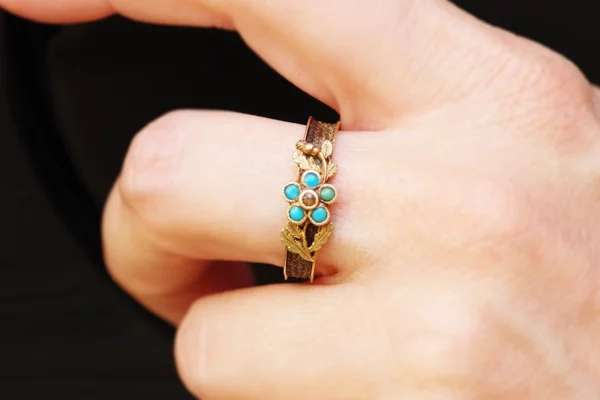
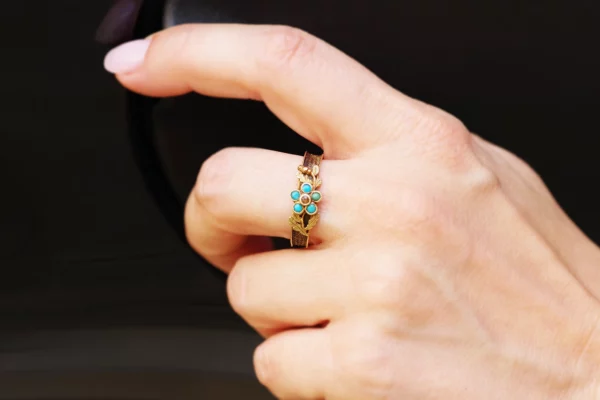 450,00€
450,00€Forget-me-not turquoise ring in 18 karat rose gold (750), featuring a central design of a blossoming branch set with five turquoise cabochons and a faceted glass. The ring’s band is hollow and holds a braided lock of hair that decorates the entire circumference of the band. This memento ring dates from the second half of the 19th century, specifically the Napoleon III period.
Hallmark: Owl
Finger size: 61 EU or 9.5 US (no sizing possible).
Band width: 4 mm.
Condition: slight deformation of the band around the hallmark area.
Weight: 1.88 gr.
-
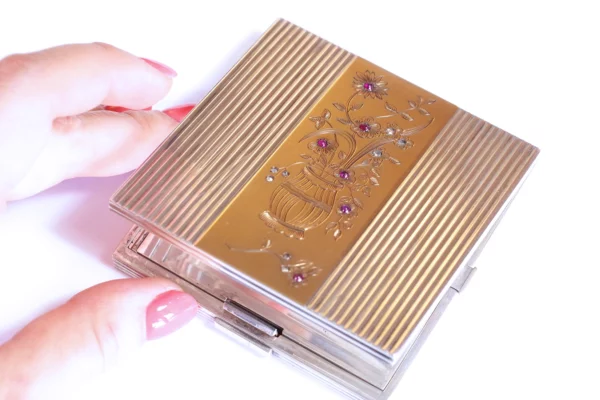
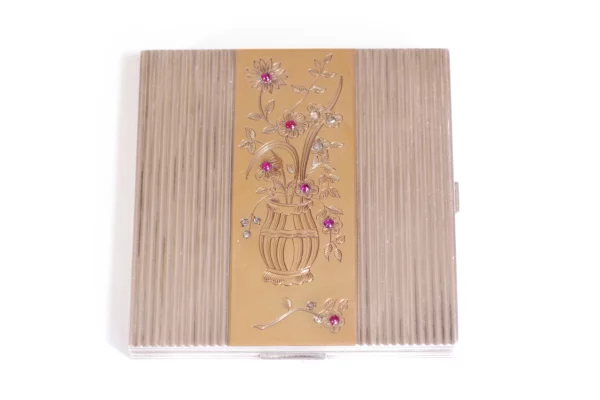 590,00€
590,00€Retro ruby diamond compact powder in sterling silver and vermeil. The case is in silver, decorated in the centre with a large vermeil band with a floral composition in a vase. The flowers are decorated with six ruby cabochons and eight rose-cut diamonds.
The powder case contains a bevelled mirror. It opens in two parts. French work in the taste of Boucheron Paris, circa 1945.
Boar hallmark, goldsmith’s mark Jacques Lucien DELETTREZ and Son (1920-1955), worked for René Boivin, traces of numbers.
Dimensions: 7.5 x 7.5 x 1.1 cm
Condition : wears, scratches
Weight : 209 gr
-
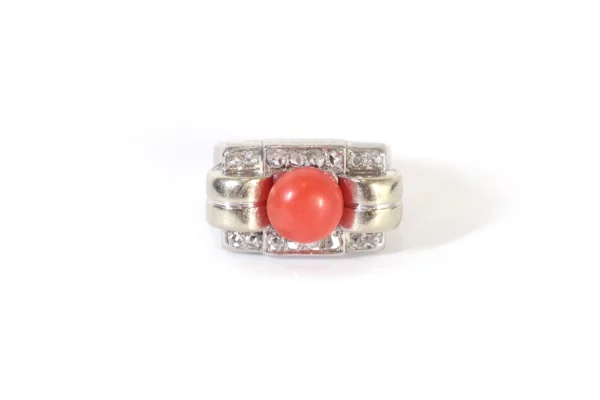
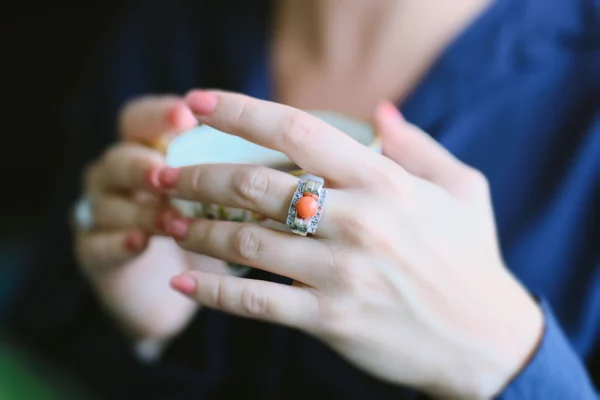 2200,00€
2200,00€Tank coral diamond ring in 18 karat (750) white gold and platinum. The ring is centred on an orange coral pearl surrounded by two rolls of gold and framed by two lines of eight rose-cut diamonds (sixteen in all). The jewellery features the geometric lines typical of tank jewellery. Tank ring, circa 1940.
Hallmarked owl and mascaron
Finger size: 55 EU or 7.25 US
Ring head dimensions: 12 x 20 mm
Pearl diameter: 8 mmEstimated diamond weight: 0.10 carat
Condition : scratches from use
Weight : 9.26 gr
-
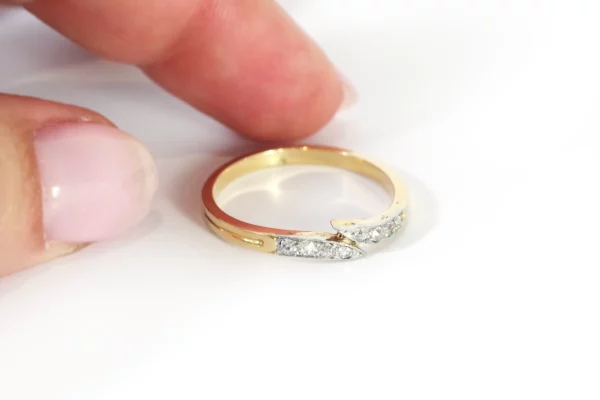
 500,00€
500,00€Antique diamond wedding ring in 18 karat yellow gold (750) and platinum. Antique ring set with eight old-cut diamonds with a platinum setting. The ring consists of two lines whose ends meet in the centre, on which the diamonds are set. Antique ring, first half of the 20th century.
Owl and mascaron hallmark (later add), Illegible numbers inside the ring.
Finger size: 56 EU or 7.5 US (can be cut to size)
Max. ring width : 3.5 mm
Estimated diamond weight: 0.08 carat
Condition : scratches from use
Weight : 2.51 gr
-
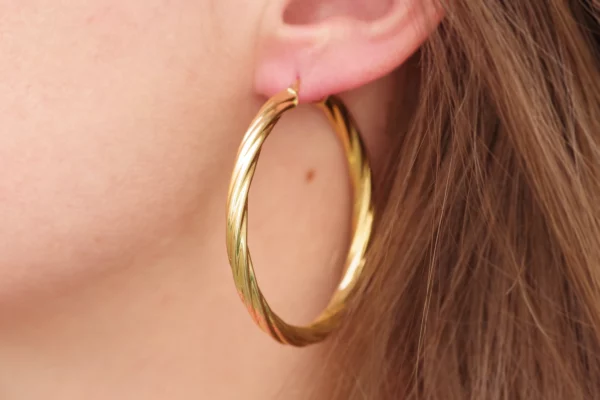
 260,00€
260,00€Big single hoop earring in 18 karat yellow gold (750). Large vintage creole earring with twisted gold pattern. Single vintage earring, circa 1970 from Unoaerre, Italian jewellery.
Italian hallmark, hallmark 750, hallmark UNOAERRE
Diameter: 47 mm
Note: for pierced ears
Note: for pierced ears
Condition: fine scratches from use, earring sold on its own.Weight: 3.27 gr
-
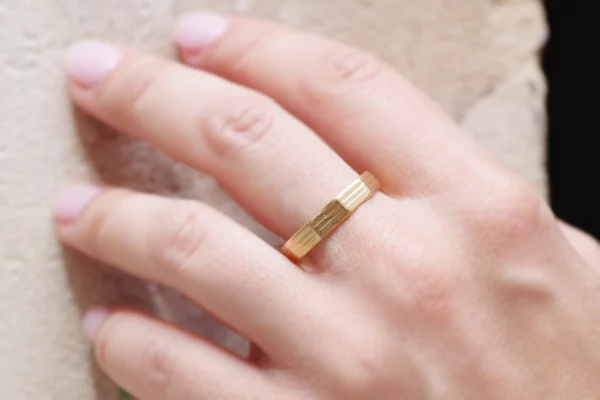
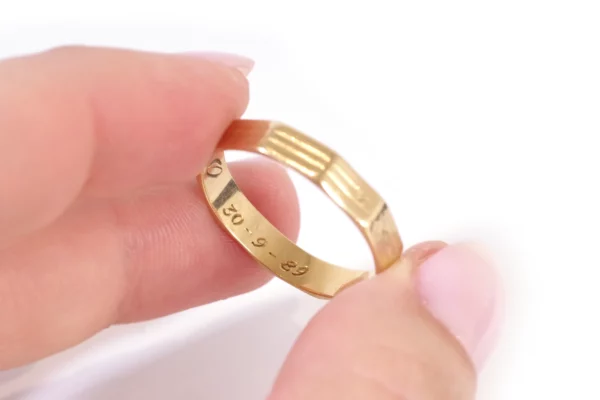 300,00€
300,00€Vintage wedding band 18 karat gold (750). Vintage wedding band decorated with fine chased lines. Inside, the ring bears the inscription V-O 30-9-89. Second-hand jewelry, 20th century, France.
Eagle head hallmark and goldsmith’s hallmark.
Finger size: 59 EU or 8.5 US
Ring width: 4 mm
Ring thickness: 1 mmCondition: scratches from use, engraving inside the ring.
Weight : 3.02 gr
